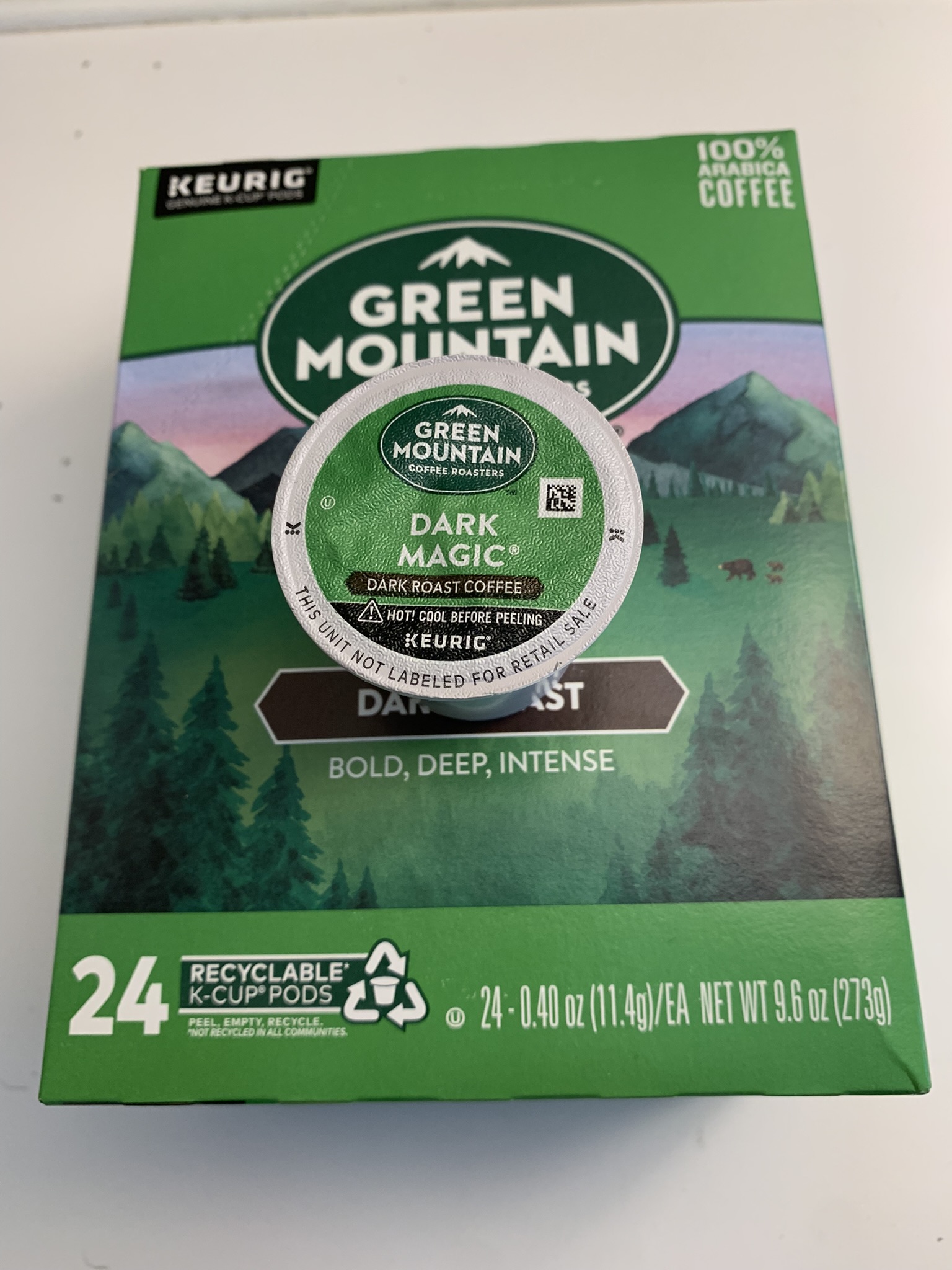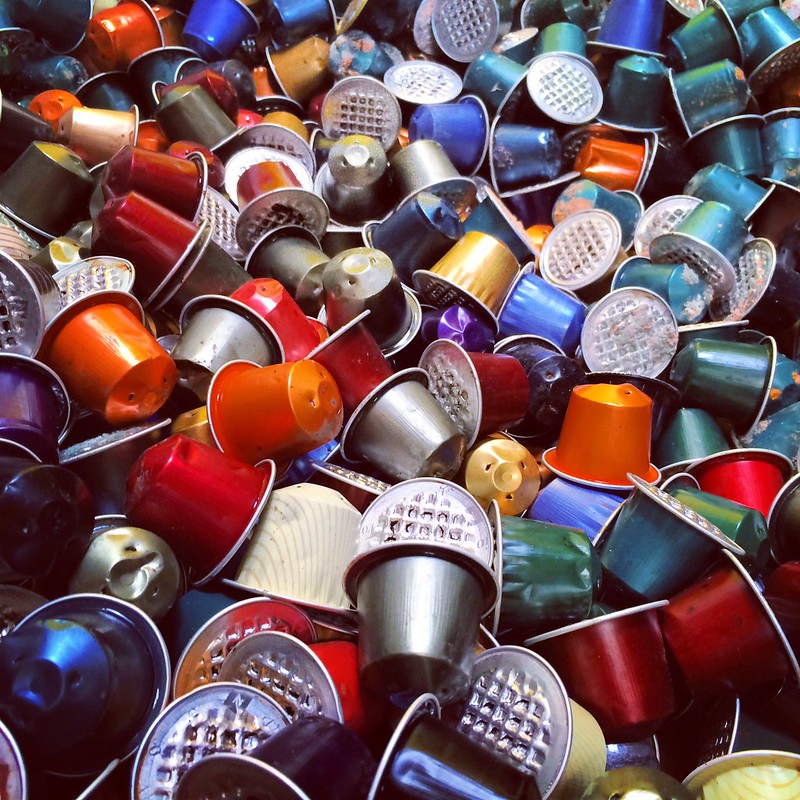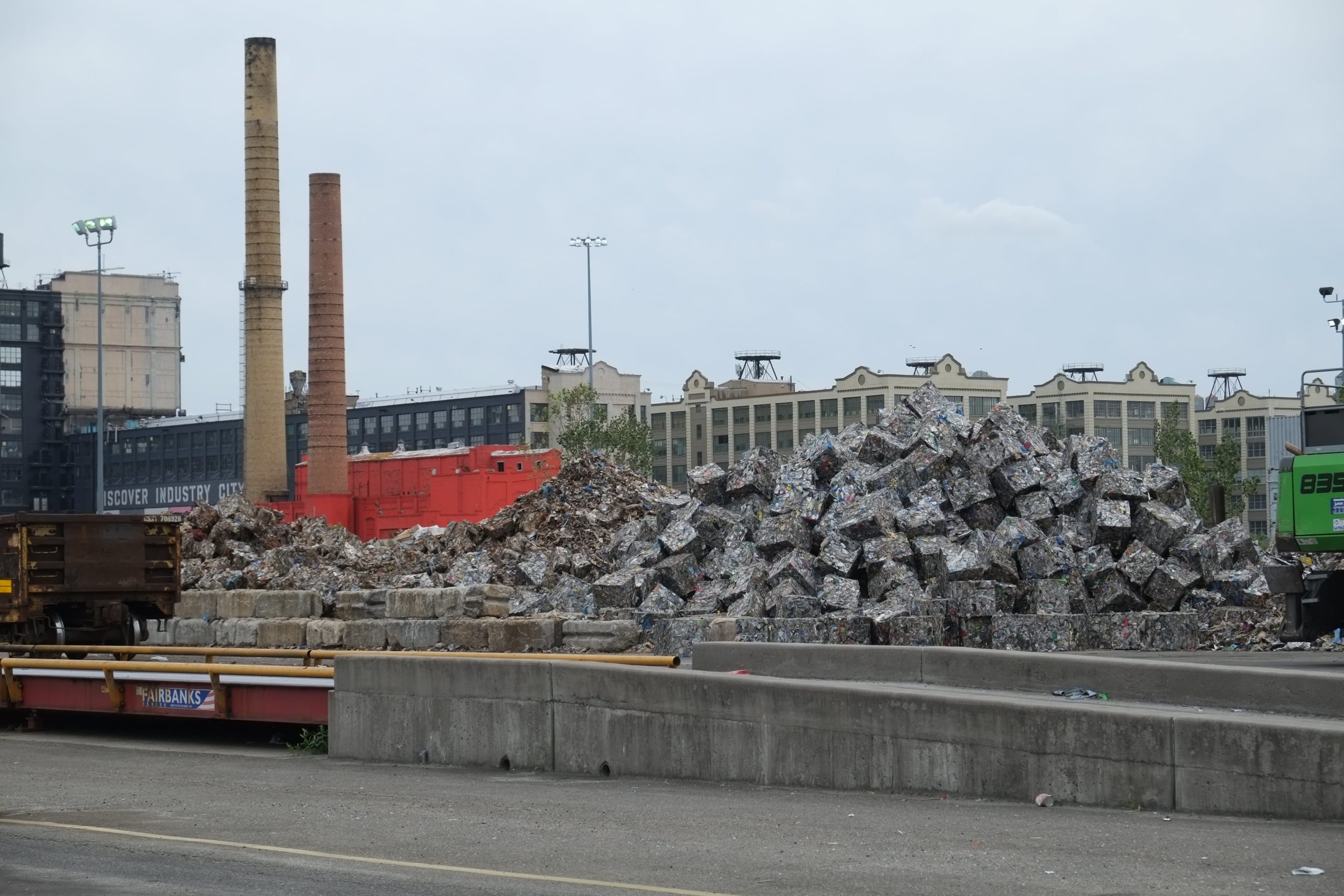- Coffee capsules are now ubiquitous: By 2025, the global market for the product is expected to grow to more than $29 billion.
- These mostly plastic pods are currently popular in Europe and North America, but research predicts their popularity is likely to grow in markets in Asia, particularly China and South Korea.
- As the global market for coffee capsules grows, so does the waste associated with it: The global footprint of annual coffee capsule waste is about 576,000 metric tons — the combined weight of about 4,400 school buses.
- Responding to pressure from environmental campaigns like “Kill the K-Cup,” coffee companies have developed capsules made from aluminum or compostable fiber; but progress to ensure that coffee pods don’t contribute to more pollution is still moving at a glacial pace.
In 2015, an anonymous user posted a video on YouTube titled “Kill the K-cup.” In shaky footage, the video shows a city overrun by a monster composed of coffee capsules, interspersed with warnings that there are enough K-cups to circle the Earth more than 12 times. “Kill the K-Cup before it kills our planet,” the video warns. After the release of the video, the inventor of Keurig’s K-Cups admitted that he “feels bad sometimes” about creating coffee pods, given their environmental impact.
Coffee capsules are now ubiquitous. By 2025, the global market for the K-Cup and other kinds of coffee capsules is expected to be worth more than $29 billion. More than 40% of U.S. households owned a coffee pod machine in 2020, and in the U.K., the statistics are similar. Coffee capsules are popular in Europe and North America, but research predicts they are likely to spread to markets in Asia next, particularly China and South Korea.
The market for coffee capsules is growing, and waste grows with it. The global footprint of coffee capsule waste is about 576,000 metric tons — the combined weight of about 4,400 school buses. Responding to pressure from environmental campaigns like “Kill the K-Cup,” coffee companies have developed new capsules to move away from plastic, like Nespresso’s aluminum capsules and compostable fiber pods. But progress to ensure that coffee capsules don’t contribute to more pollution is still moving at a glacial pace.
‘A lie built upon a lie’
Keurig, the company responsible for producing K-cups, announced in 2021 that it had converted all its pods from a kind of plastic that’s nearly impossible to recycle to polypropylene, which is recyclable. Consumers are asked to peel the lid off a used capsule, empty the coffee grounds, and deposit the plastic capsules into their recycling bins, which, depending on where they live, are then sent to local recycling facilities. In small print, Keurig adds an important clarification: “check locally, not recycled in all communities.”

The problem is that while some people might put their coffee capsules in their recycling bins, most recycling facilities, called material recovery facilities, or MRFs, are not equipped to sort items smaller than 7.5 centimeters (3 inches). According to a new report by Greenpeace, only one MRF in the U.S. accepts coffee pods made out of polypropylene.
Halo, a competitor of Keurig that sells compostable coffee capsules, estimates that 39,000 capsules are produced every minute globally, and up to 29,000 of these end up in landfills — what it calls an “insane” state of affairs. Small plastics like coffee pods, according to some estimates, can take up to 500 years to decompose in landfills, where they leach chemicals into land and water. In Brazil, only 11% of used capsules were sent to recycling facilities in 2017; while in Hamburg, Germany, coffee pods were banned in 2016 to limit waste and pollution.
Keurig says on its website that through testing with MRFs, it found that small plastics can be recovered, and their tests demonstrate that pods are not too small to be sorted with other plastic containers. Howard Hirsch, a public interest lawyer in California, says that “Big Plastic” — the fossil fuel companies that produce plastic — have sold people on the lie that companies don’t need to keep burning fossil fuels to create new plastics, and that old plastics can be recycled to create new products. “The whole thing is just a lie built upon a lie,” Hirsch says.
In a recent settlement of a class-action lawsuit, Keurig Green Mountain has agreed to pay $10 million to settle the claim that Keurig misled consumers to believe its K-cup pods are recyclable. While Keurig did not admit to anything wrong, as part of the settlement it has agreed to revise its labeling for K-Cup pods, which will now say in larger font: “Check Locally — Not Recycled in Many Communities.”
“We can’t say we won on the merits of the case,” says Hirsch, the lawyer who brought the class-action lawsuit on behalf of consumers in the U.S. “But we can claim victory in so far as we got Keurig to improve the labeling of the products and put up $10 million. I think it sends a strong message to other companies that they should be truthful and accurate in the way they describe the recyclability of their products.”
In early 2022, Keurig Canada also agreed to pay a C$3 million ($2.2 million) penalty for “making false or misleading claims that its single-use K-Cup pods can be recycled.” Keurig did not respond to requests for an interview for this article.
The European Union proposed a new set of rules in November 2022 to drastically cut packaging waste, including coffee pods. The new rules, which still have to be approved by the EU member states and the European Parliament, will require that all packaging be designed in a recyclable way, and companies should ensure it is “recycled at scale“ in reality by 2035.
Are aluminum capsules the answer?
In a paid commercial for Nestlé’s Nespresso brand, George Clooney claims “the sustainability program with Nespresso is surpassed by no one … if you are responsible and want to participate in truly recycling, it’s very easy to do.”
To appeal to eco-friendly consumers, companies like Nespresso started selling aluminum coffee capsules. Nespresso offers recycling bags that coffee drinkers can mail back to Nespresso’s boutiques or their own recycling facility, where it ostensibly “goes back into the aluminum value chain.”

In the U.S., Nespresso teamed up with the New York City Department of Sanitation and Sims Municipal Recycling so New Yorkers can deposit their Nespresso capsules in their curbside recycling bins. It’s a selling point for Nespresso, but it’s difficult to verify the claims of sustainability.
City contractor Sims runs an MRF in Brooklyn that sorts residential recyclable waste, the stuff that New Yorkers put in blue recycling bins. The city sends all the recyclables from homes and public schools to the facility, which is situated rent-free in an old New York Police Department compound. The facility hums with the sound of breaking glass and a sea of moving metal, plastic and waste being shuffled and sorted together.
Kara Napolitano, the outreach and education coordinator at Sims Municipal Recycling, says the facility has used the $1.2 million from Nespresso to develop specialized equipment that can both sort the small aluminum capsules from other waste and remove coffee grounds in the capsules using a shredder. For smelters to buy used aluminum, coffee grounds need to be separated from the aluminum capsules.
Since coffee capsules are smaller than 5 cm (2 in), the company says, they get mixed with the glass recovery stream. This waste stream is sent to a glass-processing facility where glass is separated using optical sorters, and specialized equipment such as an eddy current separate non-ferromagnetic metals like aluminum.
Small plastic pods are not recycled. “No one will buy small plastics, so we can’t invest in a sore thumb,” Napolitano says. The company declined requests to visit the glass facility where it says the aluminum capsules are sorted, nor did it share data on how many aluminum capsules are being captured.
“We don’t have public information on that data … I wonder if Nespresso will share this data at some point,” Napolitano adds.
Nespresso says its global recycling rate for capsules at the end of 2020 was 32%. But these estimates are not independently verified.

Nespresso denied requests for interviews and visits to the facility that recycles capsules. Nespresso also did not provide statistics about its most recent recycling rate for aluminum coffee capsules. James Hoffman, author of “The World Atlas of Coffee,” has described Nespresso as “a black box of a company.”
“The back end of recycling systems is non-transparent,” says Jan Dell, independent chemical engineer and founder of The Last Beach Cleanup, a nonprofit that seeks to end plastic pollution. “Companies should be required to prove that products are actually being recycled before they claim recyclability.”
Which is better: coffee pods or drip coffee?
Coffee companies like Nespresso and Keurig often refer to assessments that suggest the environmental impact of capsules is lower than drip or filter coffee. Greenhouse gas emissions, water and fertilizer use occur primarily where coffee is grown. Brewing coffee can be energy-intensive, especially if people make more coffee than necessary or keep their pot warm for a long time. This is why, according to research commissioned by Nespresso and conducted by Quantis, an environmental consultancy, drip coffee fares worse.
“What the studies show is that the capsule or the packaging is only a small part of the impact,” says Sebastien Hubert, scientific director at Quantis. “The biggest source of impact is producing the coffee. The public perception is often focused on the packaging because that’s what people see in the garbage. There is a cognitive bias … people underestimate the impact of agriculture and overestimate the impact of packaging.”
Scientific literature is divided on the issue. Some peer-reviewed research argues that farming, brewing and packaging of coffee are the most energy intensive processes. But other research also suggests that production and packaging of aluminum or plastic capsules can have higher environmental impacts compared to French press or drip coffee. Another study looking at data from Campinas and São Paulo states in Brazil found that aluminum and plastic capsules use the most energy and water, and generate the most waste compared to other ways of brewing coffee.
Waste and disposal of coffee packaging have significant impacts on carbon footprint. Research looking at coffee consumption in Thailand found that disposal of coffee and its packaging also affects toxicity in freshwater and marine ecosystems. Scientists say there aren’t enough studies or solutions that look at what to do with used coffee capsules, at least in relation to recycling and environmental impact.

Alfred Hill, a professor of chemical engineering at the University of Bath, U.K., says there is a lack of data on the merits of coffee capsules over other forms of brewed coffee, based on his research. “There were some preliminary results, but nothing has been peer reviewed or published,” Hill tells Mongabay in an email. “At present there is simply not enough data to assert any claims.”
According to Hubert, life cycle assessments are mostly focused on greenhouse gas emissions, but other impacts matter too. Coffee capsules are made from virgin aluminum. It can take twice as much energy to produce aluminum as opposed to plastic. Mining the bauxite ore to produce aluminum has significant negative impacts. Producing a ton of aluminum can generate 10 to 12 tons of waste, including 3 tons of toxic red mud. Aluminum mining is also associated with human rights violations, deforestation, pollution and poverty in the Brazilian Amazon, Papua New Guinea, India, and elsewhere.
Nespresso did not comment on how many of its capsules are currently produced using recycled aluminum.
The future of coffee pods
While aluminum and plastic capsules remain the most popular containers, compostable coffee pods have entered the market, which some scientists view as a positive step. Compostable coffee pods can be made from plant fibers (like sugarcane bagasse), bamboo or paper — all biodegradable material that people can send to a municipal composting facility or throw in a compost pile at home. Research finds that compostable coffee pods are the least harmful, compared to aluminum and plastic capsules.
But compostable coffee pods are not an easy panacea to the waste problem. Not every industrial composting facility is equipped to deal with biodegradable packaging. Reusable pods are another option, but people prefer the convenience of single-use pods.
Hubert suggests buying organic coffee, reducing energy use while making coffee, and pressuring companies to recycle are the best ways for consumers to influence the industry.
Piotr Barczak, a circular economy expert at the European Environmental Bureau, a network of 180 environmental citizens’ organizations, says focusing on consumer action is the wrong approach.
“It’s not correct to blame consumers for emissions or wastage,” Barczak says. Coffee companies could incentivize people who return capsules for recycling through a refundable deposit fee, he suggests. “These companies benefit from a lack of governance, [weak] environmental policies, a lack of enforcement, and they make huge profits — at the expense of both the environment and people.”
“Companies shouldn’t be making these things, period,” says Dell, the chemical engineer. “They need to innovate better solutions and better material … like fiber and paper.”
Citations:
Maciejewski, G., & Mokrysz, S. (2020). New trends in consumption on the coffee market. Scientific Journals of the Warsaw University of Life Sciences, European Policies, Finance and Marketing, 22(71), 132-143. doi:10.22630/PEFIM.2019.22.71.31
Marinello, S., Balugani, E., & Gamberini, R. (2021). Coffee capsule impacts and recovery techniques: A literature review. Packaging Technology and Science, 34(11-12), 665-682. doi:10.1002/pts.2606
Domingues, M. L. B., Bocca, J. R., Fávaro, S. L., & Radovanovic, E. (2020). Disposable coffee capsules as a source of recycled polypropylene. Polímeros, 30(1). doi:10.1590/0104-1428.05518
Hassard, H., Couch, M., Techa-erawan, T., & McLellan, B. (2014). Product carbon footprint and energy analysis of alternative coffee products in Japan. Journal of Cleaner Production, 73, 310-321. doi:10.1016/j.jclepro.2014.02.006
Brommer, E., Stratmann, B., & Quack, D. (2011). Environmental impacts of different methods of coffee preparation. International Journal of Consumer Studies, 35(2), 212-220. doi:10.1111/j.1470-6431.2010.00971.x
de Figueiredo Tavares, M. P., & Mourad, A. L. (2020). Coffee beverage preparation by different methods from an environmental perspective. The International Journal of Life Cycle Assessment, 25(7), 1356-1367. doi:10.1007/s11367-019-01719-2
Phrommarat, B. (2019). Life cycle assessment of ground coffee and comparison of different brewing methods: A case study of organic arabica coffee in northern Thailand. The Environment and Natural Resources Journal, 17(2), 96-108. doi:10.32526/ennrj.17.2.2019.16
Kooduvalli, K., Vaidya, U. K., & Ozcan, S. (2020). Life cycle assessment of compostable coffee pods: A US university based case study. Scientific Reports, 10(1). doi:10.1038/s41598-020-65058-1
Soares, A. P. S., Mothé, C. G., & Mothé, M. G. (2021). Comparative life cycle assessment of coffee capsule recycling process and its composites reinforced with natural fibers. Journal of Polymers and the Environment, 30(4), 1380-1390. doi:10.1007/s10924-021-02282-4
Tonelli, A., Mosna, D., & Vignali, G. (2018). Comparative life cycle assessment of different packaging systems for coffee capsules. Proceedings of the 4th International Food Operations and Processing Simulation Workshop (FoodOPS 2018), 1-9. doi:10.46354/i3m.2018.foodops.001
Samoggia, A., & Riedel, B. (2018). Coffee consumption and purchasing behavior review: Insights for further research. Appetite, 129, 70-81. doi:10.1016/j.appet.2018.07.002
Feedback: Use this form to send a message to the editor of this post. If you want to post a public comment, you can do that at the bottom of the page.
Banner image: A selection of Nespresso coffee capsules. Image by Wany Bae via Flickr (CC BY-NC 2.0).
